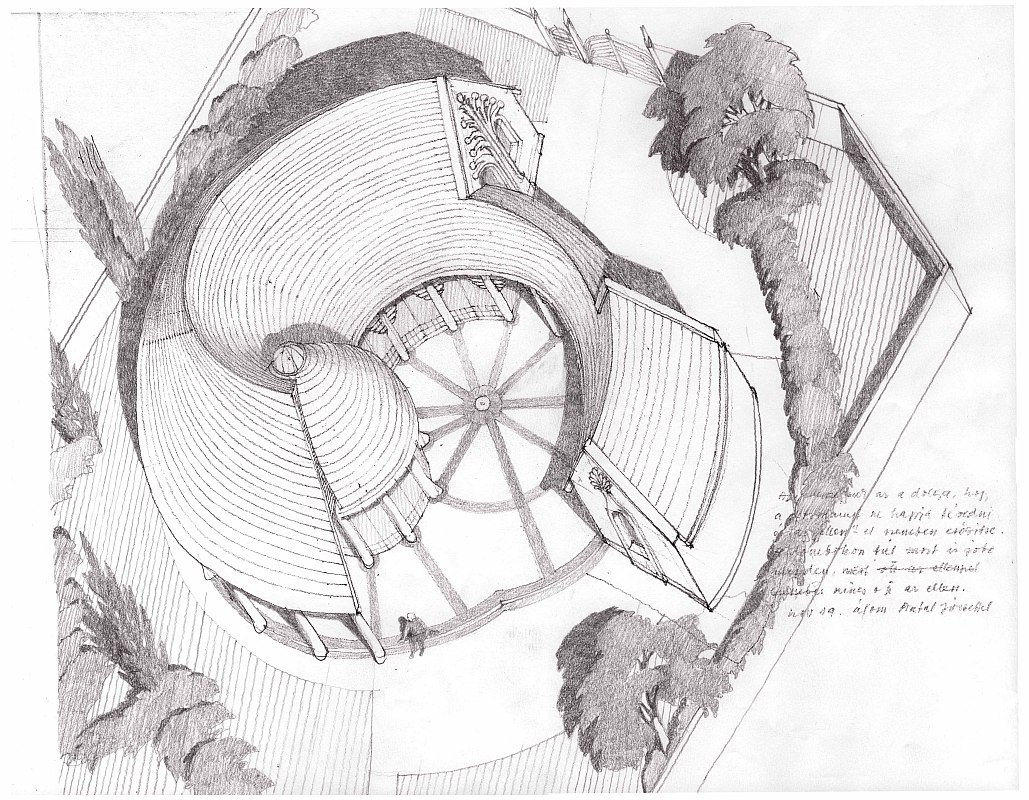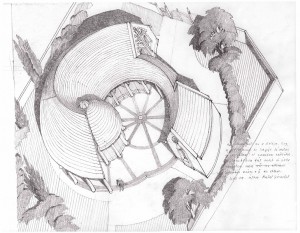Anthroposopher House
A Summarizing Work by Makovecz on the Hill
Architect: Imre† Makovecz Szöveg / text: György Szegő Fotók / photos: Tibor Zsitva
A house that Makovecz succeeded in building but which he could never move in. The afterpiece of the drama of architecture – somewhere above the oeuvre and beyond it. A chance to understand, now we can take an exam after having failed it in front of us. The significance of a house does not lie in the unity of functions and form – it can be approached from the direction of moral philosophy. I relied upon texts by István Kálmán, one of the leading characters of anthroposophy in Hungary. He and Makovecz started out towards the „freedom philosophy” of Rudolf Steiner after 1956 within an illegal Hungarian groupwork. Later on Makovecz left the Anthroposophian Society as it was too much institutionalized for his taste, but interpreted and understood the world in the wake of Steiner and he made his buildings in his spirit.
„My architectural activities and my life has an axis, and this axis is anthroposophy, and this whole activity is strung on it, every explanation is possible only starting from this” – this is how István Kálmán quotes Makovecz in his memoir. We could react to this with the question: What has it got to do with architecture? Kálmán remembers their first joint trip to Goetheanum in Dornach in 1965. Under this influence the young Makovecz defined at first „instinctly, then absolutely consciously that [anthroposophy]… is misunderstood, is degraded into the sphere of privacy… instead of behaving normally. This means they could make a life practice in the field of their own profession, in their own environment from the liberating, clear and logical thoughts that they managed to understand with the help of Rudolf Steiner” – said the architect.
On this trip Makovecz and his friend met Nagy Emilné dr. Maria Göllner, the founder of the Hungarian Anthroposophian Society who lived in emigration then, and the Viennese Friedl Meangya, „who was then the greatest eurhythmist in the world, and conducted exercises for us in Budapest… in which Imre also participated. These exercises led to Makovecz’s »Movement experiments«” – recalls István Kálmán. The first impression is also a meeting with the spiritual leaders. At home it was impossible to complete it with reality, whilst anthroposophy was excluded from social existence, and according to Kálmán his friend avoided being followed as an occult leader, which would have meant that anthroposophy would have been associated with his character in the country. He compares Makovecz to the philosophers of the ancient world who experienced that „the mass that had taken on Christian faith, but had not understood it has destroyed the sacred sites of the pagans, and exiled their scientists”. I understand that this is why Makovecz offered it as a helping mediator the attraction he experienced „towards the Hungarian folk art, the Hungarian past, the atmospheres of Central Europe”. Moreover, he was also able to pass it on to his students in the wake of Károly Kós. The other study by Kálmán interprets the age of King Stephen. Not only the well-known eastern aetiological myth – he also analyzes a thread from the monastery of the German Gandersheim so that we can see the spiritual medium of the foundation of the Hungarian state. In this study the monastery and Saint Stephen are viewed as the builders of a spiritual bridge between the east and the west: the monastery was built by Hroswitha, a poetess (932-1002) who matched the Platonic spirituality of the Greek with the esoteric Christianity. This is the time when Gisella, who was asked by prince Géza – Stephen’s father – to marry his son, was about to become a nun. A photograph by Kálmán shows Gisella’s tomb in the position of a cave-grave which has a small Gothic gate as its opening. Now when standing outside the Makovecz House I recognize the archetype of the tracery: in the windows designed by Makovecz the medieval archetypes of the „wings” and the „third eye” referred to as vesica pisces appear. The backs of the vaults arch like eyebrow-wings – this sign is compared to the angel-wings of Wenders in The Sky above Berlin by Anthony Tischhauser (in Bewegte Form, der Architekt Makovecz Imre, Urachhaus Stuttgart–Gyorsjelentés, Bp. 2001), a monographer of Makovecz (the present is inserted by anthroposophy into the programme of the development of the humanity of the self as the age of Michael archangel). The wings, the flight-experiments of the eurhythmia also plays an important role among the signs of Santiago Calatrava, another genious architect with anthroposophian associations.
The wing-eye symbol is also a striking motif on his own house, being a sign of almost Old Testament relevance. However, a prototype of this opening frame is present the weekend house in Csipke Street (1972), the Culture House in Sárospatak (1974), the Richter House in Budapest, the Thaly House in Tördemic (1988), the Koch House in Recsk, in the church above the gate in Siófok (1990), or in a more developed form in the house in Kolontár (2011) designed by Makovecz. The wings in Sevilla (1992) and on the gate of the church in Százhalombatta (1993) „moved” upward, in the scenery of the The Miraculous Mandarin (1993) in the Opera House and in designs of the Budapest Expo (1996) they already function as leitmotifs – including the embraced circle form. The latter, a germinating core, can be interpreted as the cosmic globe-symbol of the Lord / Son and Mary. Now the version of the corner window facing the court is made after the present-day topic of a „crackling core”, the best known examples of which are seen on the Demeter centre in Hannover (1998), the Atlantis-tower of the Venice Biennale and the steeple of the church in Csenger (2000), later on in the design of the baths complex in Eger (2001) or that of the monument erected to the Hungarian casualties in Novi Sad (without date). The motif of a rampart in the form of a house „grown out of the ground” can only be interpreted here as stone shields owing to the limitations of the site, much in the same way as a „pile fort”. Its constituents show analogy with details of the Nagyszentmiklós treasure – the scene of ascension or the tombstones stuck to fort-churches. The roof is covered with round-end tiles made of earth. New motifs are concrete leaves by Anna Makovecz in the bay of the yard. Embracing the garden, the horizontal plan reoccurs all throughout the oeuvre – from Sárospatak to the Natura House Überlingen (1993), from the designs of the wine-proceeding works in Siklós (2000) to that of the Andor House (without date) in Alaska.
The entrance is organized on the focus of the horizontal plan. This way those arriving here can orientate themselves immediately – this is what makes the experience of the space familiar and cozy. At one end of the arch there is a rounded cupola with an opeion to create a communal space which is supported by eight columns in line with the prototype in Dornach. The function of this tent in the sky is self-evident in the oeuvre. On the other side, there is a studio meant for his wife, an artist – this room is organized as a chevelure of the circular space. The communal room embraces a kitchen and a fireplace, the former being positioned on the tangent of the circle. The inner facework of the roofing is made of shingles which gently transforms into a pointed arch to frame the opening as the shell approaches the columns. In between the two end-points two galleried nets open from the bent portico facing the yard. Behind the staircase of this there is the bath with access from the sides in two directions. Laid down as a net, the ceramic flooring does not integrrate, which makes the furnishing requiring unique solutions even more complex. Imre Makovecz designed a house for himself as an anthroposopher architect. The qualities it embodies are to be judged starting from the history of ideas as „anthroposophy reached deeper, through the heart into will” in its designer – writes István Kálmán who explains with Rudolf Steiner: „Hungarians belonged to the I-culture of Central Europe, but the eastern components of their origin-powers came to be obstacles of the development in the west. These must die out and be transformed just as István Széchenyi wrote: limitless fire must be purified and ascend into gentle zeal, wild forces into championing firmness, destructive drunkenness into generosity.” This kind of ascension is phrased by the architecture of Makovecz as a constructive type of magic.
Építész tervező / architect: Imre Makovecz
Építész munkatársak / fellow architects: Balázs Imre Arnóczki, Attila Ferenc
Statika / structure: László Pongor













